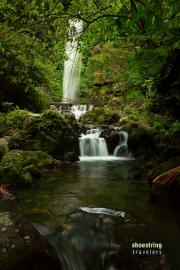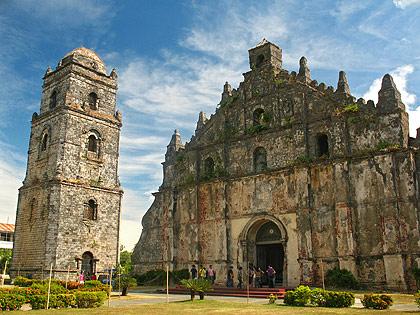 The San Agustin Church in Paoay, Ilocos Norte
The San Agustin Church in Paoay, Ilocos Norte
You may also check these
https://shoestringtravelers.com/?q=node/14
We may love travel but visiting old churches did not really interest us that much. That is, until we came to PAOAY in Ilocos Norte. During the summer of 1999 we embarked on our first road trip to the Ilocos Region and decided to drop by the San Agustin Church, declared as a UNESCO World Heritage site in 1993. It’s hard not to get fascinated with this church because of its unique architectural style sometimes known as Earthquake Baroque – a reference to the fusion of European Baroque Architecture, Oriental architecture and earthquake-resistant design elements. Constructed from coral rocks and brick, the San Agustin Church was started by Agustinian friars in 1694. Unlike most other churches, however, the San Agustin Church draws attention not only to its façade but to the buttresses that extend out from the exterior side walls. The 24 massive buttresses are meant to absorb earthquake forces but have also uncannily contributed to the aesthetics of the structure.
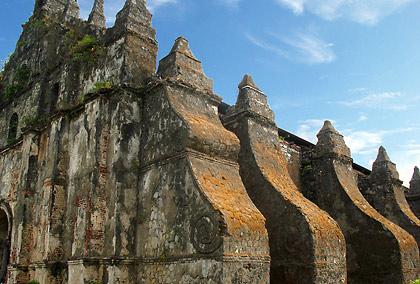 Massive buttresses on the exterior side walls are used to reinforce the San Agustin
Massive buttresses on the exterior side walls are used to reinforce the San Agustin
Church against major earthquakes.
In our later visits to Paoay we chanced upon the Herencia Café at the small plaza in front of the San Agustin Church, the restaurant famous for itspinakbet pizza. This popular dish wasn’t probably part of the menu yet when we first visited Herencia but we really enjoyed their pasta. We later found out that what added to the delectability of the pinakbet pizza was the use ofbagnet or deep fried pork, Ilokano style.
Other places we visited in Paoay were the Sand Dunes, Paoay Lake and the Malacanang of the North. The latter is a large, two-storey residence built by the late President Marcos. Furniture, beddings and other furnishings are well-maintained and the place is still a popular venue for weddings. It also has a magnificent view of Paoay Lake.
How to Get There
If you’re going up north by car on the national highway to Laoag, drive past Badoc until you reach Marcos Avenue leading to Paoay proper. Turn left on Marcos Ave. (right goes to Batac town proper). This is not hard to miss as you will see a sign on the road directing motorists to Paoay. You will pass by Mariano Marcos State University on the right. This road leads all the way to Paoay town proper and passes by the San Agustin church.
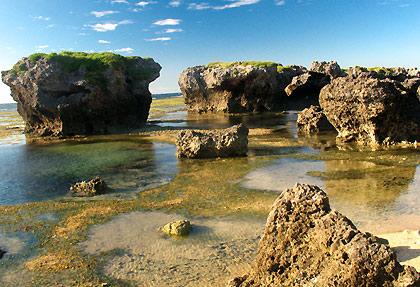 There are numerous coral rocks and hundreds of tidal pools such as the ones shown above
There are numerous coral rocks and hundreds of tidal pools such as the ones shown above
at the Pangil Coral Gardens in Currimao, Ilocos Norte.
CURRIMAO was off our travel radar until Art, a friend and native of Paoay, invited us to visit the place after we had sauntered around in his hometown. Currimao seemed like an ordinary coastal town until we came to the Pangil Coral Gardens. There, stretched out for approximately two kilometers was a long, almost unbroken line of tall coral rock formations, many extending to more than 12 feet in height. This impressive display was on the beach at the side of the road so it was possible for us to park the car on the roadside and walk on down towards the coral gardens.
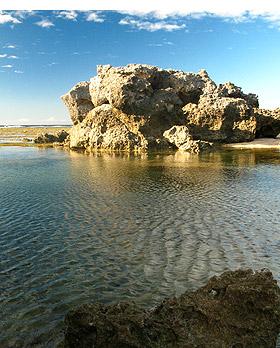
Many of the rock formations in Currimao are massive and tall enough to provide a perfect shade at noon for a lunch picnic. As we took lunch some scraps fell on the tide pool at our feet and, to our amazement, coral fish started appearing from nowhere to gobble up the tidbits. Soon they were waiting at our feet for more. This led us to another pleasant discovery. There were literally hundreds of tidal pools, big and small, shallow and deep, formed when water was trapped in the corals by the low tide. Initially we couldn’t see any fish but as we started throwing bread crumbs at the pools, colorful fish soon started to come out of their hiding places. We stayed the whole afternoon until sundown playing with the fish in the numerous pools until a magnificent sunset reminded us that we had better get going.
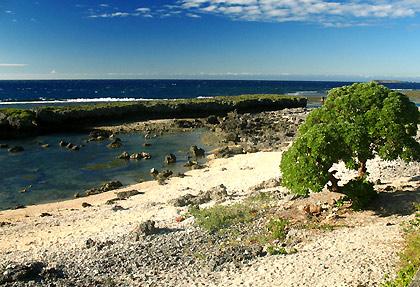 View of the Pangil Coral Gardens from the road, Currimao, Ilocos Norte.
View of the Pangil Coral Gardens from the road, Currimao, Ilocos Norte.
How to Get There
If you’re driving north to Laoag on the national highway, drive past Badoc until you reach the point near a Shell station where the road branches off to Currimao (the Currimao-Paoay-Suba-Balacao Road). Turn left on that road and it will take you along the coast to Currimao town proper. This same road also carries you all the way to Paoay town proper. There are now several resorts along Currimao’s coast close to the location of the Pangil coral gardens.





